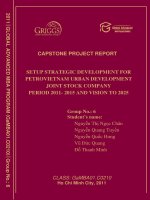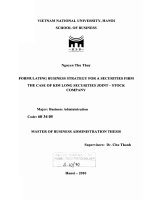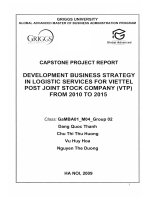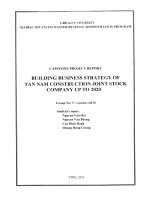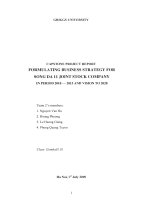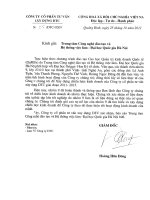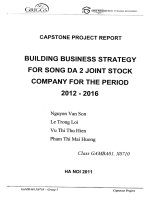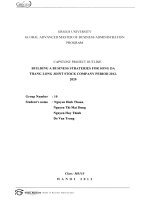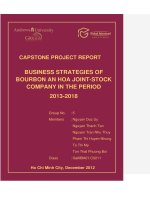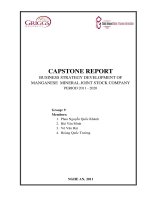Buildng business and development strategies of Song Da 5 joint stock company - period 2012 - 2017 strategic vision to 2020
Bạn đang xem bản rút gọn của tài liệu. Xem và tải ngay bản đầy đủ của tài liệu tại đây (782.94 KB, 77 trang )
BUILDING BUSINESS AND DEVELOPMENT STRATEGIES
OF SONG DA 5 JOINT STOCK COMPANY
- PERIOD 2012 - 2017
STRATEGIC VISION TO 2020
CAPSTONE PROJECT REPORT
Ho Chi Minh City
Group No.: 7
Le Van Tam
Bui Tien Hung
Vo Cong Danh
Ho Duc Tuan
Class: GAMBA V0210
1
Table contents
1.General context, the necessity and significance of research……….………….… 6
2. The objective and scope of the study ………………………………….…….……7
Research Methodology………………………………………………………… … 7
3. Structure of the Report ………………………………………………….… ………8
Chapter 1: Theoretical basis of the report… ………………………………… …9
1. The concept and classification of business strategy ……………… …….9
1.1. The concept of business strategy
1.2. The role of business strategy……………………………………… 9
1.3. The basic features of the business strategy……… ………………10
1.4 The construction process business strategy ……… …………… 10
2. Internal and external environment analysis…….……… 11
2.1 Analysis of the external environment factors…… 11
2.2 Analysis of the internal environment factors………………… ….………….… 16
3 Develop matrix to select the business strategy the company …. 16
3.1 External factors evaluation Matrix …… ……….16
3.2 Internal factors evaluation Matrix .….……….… 16
3.3 Competition profile Matrix ……………….….18
3.4 SWOT Matrix…………………………….…… 19
4 Business strategy selection……………………………….………20
4.1 Organization and implementation ………………………….….21
4.2 Effective assessment strategy has established…………………. 21
Conclusion chapter I……………………………………………………………….…22
CHAPTER II: ANALYSIS OF BUSINESS PRODUCTION ACTIVITIES
STRATEGY OF SONG DA 5 JOINT STOCK COMPANY .……………………23
2.1 Introduction overview of the Song Da Corporation 5 ……………………… ….23
2.1.1 Formation and development of the Song Da 5:….…….………….…… 23
2.1.2 Structure organization of the company………… …………… ……… 25
2.1.3 Main Business industry.…………………… ………………….……… 28
2.1.4 Introduction about the Company’s products…………………………….28
2.2 The business situation in 2008 - 2011 and the first six months of 2012…… … 29
2.3 Analysis of the business situation of the Song Da 5…………………….…….… 31
2
2.3.1 External Environment Analysis …………………………………… … 31
2.3.1.1 Macro environment Analysis……… ………………….…… 31
2.3.1.2 Industrial and competitive analysis……….………………… 34
2.3.2 Internal Environment Analysis ………………………………………… 41
2.3.2.1 Resources …………………………………………………… 41
2.3.2.2 Strengths ………………………………………………………45
2.3.2.3 Weaknesses ……………………………………………………46
2.3.2.4 Competition in the market …………………………………… 46
2.3.3 The strategic selection matrix ………………………………………… 47
2.3.3.1 Internal and external factor Matrix …………….………………47
2.3.3.2. BCG Matrix………………………………………………… 50
2.3.3.3. SWOT matrix analysis …………………………………….…52
Conclusion chapter II ……………………………………………………………… 56
CHAPTER III: BUILDING BUSINESS DEVELOPMENT STRATEGIES OF
SONG DA 5 JOINT STOCK COMPANY - PERIOD 2012 - 2017 VISION TO
2020 ………………………………………………………………………………… 58
3.1 Objectives of the Song Da 5 BY 2017………………………………… 58
3.1.1 The basis for objective building…….………………………… 58
3.1.2 Vision, Mission, Core Values ………………………………… 59
3.1.3 Objectives………………………………………………………. 60
3.2 Business strategy proposal Period 2012 - 2017………………………… 61
3.2.1 Business strategy selection…………………………………… 64
3.2.2 Business Strategies of the Song Da 5 Period 2012-2017……… 65
3.2.2.1 Company level Business Strategy …………………… 66
3.2.2.2 Partial level Business Strategy ……………………… 66
3.3 The solutions to implement business strategy period 2012-2017 and vision
to 2020 of the Song Da 5 Joint Stock Company. …………………………… …… 66
3.3.1 Production management solutions group.……………………… 66
3.3.2 Marketing management solutions Group ………… ………… 68
3.3.3 The human resource management solution Group……………….69
3.4 Some recommendations for the agencies and the State………………… 72
3
3.4.1 Recommendations for the management agency on the Song Da
Corporation:……………………………………….………………… 72
3.4.2 Recommendations for the Government and the State management
agencies: ……………………………………………………………….73
Conclusion Chapter III ……………………………………………………………….73
CONCLUSION OF THE REPORT……………………… ……………………….74
REFERENCES …………………………………………………….…………………76
4
Acknowledgement
First of all, we sincerely thanks to the teachers of Hanoi National University and
Griggs University, USA. Thanks to the enthusiasm and responsibility of the lecturers,
we have accumulated extensive knowledge to serve the useful works in the future.
Through this report, we would like to send my sincere feelings to all members of the of
Global Advanced program, which is the program director, registrar department and
Student Affair Department of V0210 has created all conditions for us to learn in the
best qualified and favorable environment.
Finally, our group would like to send Board of Director Songda 5 Company and the
Company where we are working has created conditions in time for us to complete the
course without any difficulties and obstacles.
Because framework of the report and the time to learn about the company is limited,
our team tried to complete in the best way by our knowledge and ability, however still
having inevitable shortcomings, we look forward to receiving your valuable
contribution of lecturers and friends.
Member of Group 7
5
INTRODUCTION
1. General context, the necessity and significance of research
In 2011, the world situation still had complex problems, the global economic
recovery takes place slowly, the risk of economic financial re-crisis still had
implicities, but the changes has passed, it's time for global economy prepares to meet
next challenges and opportunities. According to many economic experts said that the
global economy in 2012 is still difficult but there will also be highlights and
advantages. Due to the impact from the crisis of the world economy, in 2011 Viet Nam
has tightened credit, reduce gradually public investment, thus, in 2012 the domestic
economy is still affected.
After 17 years of integration with the ASEAN countries, Viet Nam – USA
relations normalization (1997-2012) and 5 years of economic integration in the world
WTO (2007-2012), the construction industry has made a lot of progress and
contribution effectively in the country's economic growth and creating position and
capacity to enter into an implementation period of the industrialization and
modernization process of the country. This is the period with many significant changes
in quality and quantity in the development of the construction industry. Corporations,
large companies were established to consolidate and further intensive investment to
technological innovation, increase production capacity and competitiveness of the
products of industry, preparing the premise for regional and international economic
integration in the next stage. Vietnam's economy continously intergrates, develops,
and become the centre of dynamic economic growth in Southeast Asia. Construction
industry is facing the enormous challenges and potential, which occupies an important
position in the national development strategy by 2020 and vision to 2030.
Song Da 5Joint Stock Company with more than 20 years of construction and
development has continously developed in the organization scale, functions, tasks, job
structure and the total value of business production. Currently, Song Da 5 Joint Stock
Company has been involved in building many key industrial projects in the country
such as hydroelectricity, road and bridge construction, project construction and
installation and the most advanced construction materials manufacturing. Therefore,
6
the implementation of strategic activity and plans objectives for the company to make
long-term development orientation, playing an important role in the development of
the company in particular and the construction industry in general.
After studying about Song Da 5 Joint Stock Company, Our group 7 decides to
learn and study about "Building business and development strategy of Song Da 5 Joint
Stock Company – Period 2012 - 2017 vision 2020". This is the main construction unit
of hydroelectricity and civil works projects in Vietnam, and is a reputable company of
Song Da Corporation.
2. Research objectives and scope
Objectives:
- Develop theoretical basis for business strategic planning of the Song Da 5
Joint Stock Company.
- Analysis and evaluation of the micro and macro environment, and internal
environment of the company from which identifying the opportunities and threats from
the business environment; strengths and weaknesses affecting the development of the
company.
- Develop objectives business production strategy for this company form now
to 2020 and proposed that strategic objectives implementation plan helping the
Company to develop sustainably in environment of competition and integration.
The research object and scope:
- The research object: Song Da 5 Joint Stock Company. However, to analyze
and clarify the contents of the research, the report has expanded research object to
competitive companies in the construction industry.
- The research scope includes issues related to the business strategy of Song Da
5 Joint Stock Company in the business operation field.
- Duration of studies through the company's statistics from 2008 to the end of
June / 2012 and other factors affecting the business production of the Company until
2020 to analyse and evaluate the business production situation.
Research Methodology
7
The report focuses on research and analyse the information and secondary data
collected through the mass media and directly from the Song Da 5 Joint Stock
Company in the most basic contents.
The research and development of strategic selection matrix is implemented by
expert method, means that consulting the opinions of the experts who have a deep
understanding about products on the market. The advantage of this method is simple to
implement, but this method also has the drawback that is the level of accuracy is often
not high compared to the actual survey because it comes from the subjective intentions
of experts. However, this method is enough to build a good business strategy.
3. Structure of the Report
In addition to the preamble, the conclusion, the report is structured into three
chapters; the content summary of each chapter is presented as following:
Chapter 1: Theoretical basis of strategy and business strategy: This chapter
provides a basic concept of business strategy and business strategic planning process.
It also gives the matrixes helping to select business strategies.
Chapter 2: Analysis of business production operation strategy of the Song Da
5 Joint Stock Company: Introduction about the foundation and development of the
company, the main business products, brief assessment of business operation situation
of the company in recent times. Analyzing external and internal environments,
strengths, weaknesses and setting the matrixes of IFE, EFE, and BCG. The conclusion
chapter evaluates the business plan implementation situation, the shortcomings and the
necessity to build business strategy vision to 2020.
Chapter 3: Building some measures to improve the business strategy in the
Song Da 5 by 2020: Setting the goals, vision, mission, core values, proposing and
selecting business strategy period 2012-2017, the strategy implementation solution and
a number of recommendations for the senior agencies and the State in order to improve
production efficiency in the company.
8
CHAPTER 1: THEORETICAL BASIS OF THE RESEARCH
1. Concept and clarification of business strategy
1.1 Concept of business strategy
.The concept of strategy has emerged from a long time and have more specific
concepts such as; Business Strategy is the operation direction of the enterprise, it
specifies the type of product or services that the enterprise undertakes, business scale,
production resources, profitability and growth prospects of the enterprise.
In the present context, the term and concept of strategy of military strategy used
in the field of management to business strategy. The figure below describes the
business strategy:
Figure 1.1. Business strategy
Các
A clear concept of business strategy outlined in the syllabus of Master of
Business Administration - Griggs University as follows: "a series of commitments and
actions that a company uses to gain a competitive advantage by exploiting core
capacities in a certain market''
1.2. The role of business strategy
. Identifying strategy is a necessity work for the existence and development of
any enterprise because; to survive and develop in the current market mechanisms, it is
necessary to know the existence environment of the enterprise.
Business strategy helps enterprises to capture the market opportunities and
creates advantages on the mảket by applying the limited resources of enterprises with
Strategy
Strengths
Weakness
Opportu
nities
Threats
Internal
External
Application
&
Maintaining
Applcati
on
Discovery
Overcome
Prevention
9
high results in order to achieve proposed goals, helps enterprise to consider and
determine which direction should to go.
Business strategy creates a solid basis for the enterprise, setting out the policies
and decisions of business production that is consistent with the fluctuations of the
market. Besides, business strategy also reduces the risks and enhances the ability of
enterprises in taking advantage of business opportunities as they emerge.
1.3. The basic features of the business strategy
- Defining the basic objectives to achieve business direction.
- Caculating the orientation of the business strategy to ensure enterprise to
continuously develop in the business environment which has frequent changes.
- Considering the reasonableness and adjusting to suit the business environment
to ensure efficiency and overcome the caused strategic orientation.
- Building on the basis of competitive advantage of the enterprise to ensure
maximum mobilization and good mixture of the exploitation and resources usuing,
promoting the advantages, catching the opportunities to take advantage of competition.
- It is reflected throughout the process, business strategy always has thought of
offensive, winning in the business market and are built in a long period of 5 to 10
years or further strategic vision.
1.4. The business strategy construction process
Business strategic planning process is described according to the following steps
of Figure 1.2:
10
Figure 1.2 Business strategic planning process
1.5. The mission or objectives of the company
Michael Porter explains the necessary of the prospect in competition "because if
people do not get a clear perspect on how to become completely innovation and
unique, meets requirements of different customer better than competitors, they will be
swallowed alive by the violence of competition. "
Theory and practice shows that: any a viable prospect must present the core ideas of
the company. Because vision is constituted by the core values and principles and
systems guiding principles. Core purpose is the most basic reason of a company to
exist. And there is no universality in establishment of core values, each company has
its operation practices that the company builds it’s core values.
2. Analysis of the Internal and External environment
Environment is existing factors, forces, institutions that having influence on
operation results of the organization. The role of the environmental analysis is the
fundamental basis for the planning or confirming the functions and tasks of the
organization. Business environment of the organization, including the external
environment and internal environment.
Administrators can not form a long-term orientation or build a strategy if they
do not understand about the strategic situation of the company, the nature of the
competition conditions that it must face, the way to create a suitability between
Mission or objectives of the enterprise
Internal environment
analysis (S,W)
External environment
analysis (O,T)
Strategic selection
Strategic implementation
Result checking and evaluation
Feedback
11
resources and capabilities with those conditions. To analyze the internal and external
environmental factors, we can use the available data or survey research from inside
and outside the company.
2.1 Analysis of the external environment factors
Reviewing the environment requires overall research of all the factors of the
external environment. Thanks to the review, the enterprise soon recognizes signs of
potential changes in the environment and finds out the change is happening explicitly.
Monitoring the environment means that observing the change of environment to
identify key trends arising from the signs that the environmental review has found. By
monitoring, the company will be better prepared for the introduction of new products
or services at the right time, gain competitive advantages from opportunities
Figure 1.3. Macro environment
General Environment:
Is the broad social aspects in the society that affect industries and companies in
the industry. General environment with the nature of macro includes factors such as
demography, economy, politiy / law, society culture, technology and global. Changes
in the general environment can have a direct impact on any force in the industry,
altering the relative strength to other forces and to itself, finally, it alters the
Political and legal
environment
Economic
environment
Global
environment
Technological
environment
Socio-Cultural
environment
Internal
enviromental of
the enterprise
Demographic
environment
12
attractiveness of an industry. Therefore, the external environment analysis helps to
know the organization is facing challenges and what opportunities to get the right
development direction.
Economic factors:
Economic environment indicates the nature and direction of the economy in
which the enterprise is operating. This is the most important factor in the macro
environmental factors. It affects directly the potential attraction of different strategies.
So, the enterprise needs to study the economic environment including study of
important factors such as the growth rate of the economy, interest rates, exchange rates
and inflation rate to recognize the change, trends and strategic implications of this
important element.
The legal and political factors
Factors show the stability of political institutions, constitution, government
policies directly affect the production environment and the business of industry or
enterprise. Enterprises should carefully analyze the management policy of the state,
the laws relating to business activities or other special incentives, trade barriers
Socio-cultural factors
This is the factor which related to the attitudes of the society and cultural values
because they base social basis. That is the changes of living style, living standard,
consumption habit, occupational expectation, population growth rate, popolation
transfer, diversity of the workforce, tradition, beliefs, customs etc. when these changes
orcur they will create oportunities, challenges or risks for industries or enterprise.
Demographic factors
Technological factors
Global factors
*Industrial Environment
13
Threats from new companies
Potential competitors of an enterprise are the ones which are going to join the
industry, can affect to the structure in the future. More or less potential competitors,
strong or weak presure depend on the attractiveness through rate of profits, advantages
of scale, product differences, capital requirements, conversion charges, accession of
distribution channels, cost disadvantage, goverment policies, capable of dealing
actions.
Threat from new companies
Potential competitors of a business enterprise is prepared to entry may affect the
structure of the industry in the future. Potential competitors is more or less, their
pressure on industry is strong or weak will depend on the attractiveness of the industry
that is reflected in aspects such as profitable rate, the scale advantages, the product
differentiation, capital requirements, switching fee, access to distribution channels,
cost disadvantages regardless of scale, government’s policies, actions can deal with.
Power of the suppliers
The power of suppliers shows ability of deciding their transaction conditions
for the enterprise. Main suppliers may have to accept the terms that enterprise offers,
thanks to that, the enterprise can reduce costs and increase profits in production, in
contrast, large suppliers can put pressure on with production industries in many ways,
such as high prices of raw materials to share the profits of the industry. The
determinants of supplier power is expressed through: -
Power of
buyers
The new competitors risk
Competitors in
the industry
The competition
between the
existing firms in
the industry
Power of
the
suppliers
The threat of
substitute products
Threat from new
companies
Pressurization ability of
suppliers
Pressurization
ability of Customer
the risk of substitute products
and services
14
The level of concentration of suppliers. The power of suppliers will be great, if
their concentration is high. If the supplier of a enterprise must compete with other
suppliers, it is likely that they will have to accept unfavorable terms, because
enterprise can quickly switch to ordering other provider, so suppliers have to accept
the situation of being price squeezed.
The level of input standardization. The input is standardized also increases
competition between providers and thus reduce their power
Cost of changing suppliers. The higher the cost is, the more enterprise will
must suffer unfavorable terms that set by the provider, because the transition from this
supplier to another supplier will force prodution enterprise must suffer the higher costs
.The risk of consolidation increasing among suppliers and manufacturing
units. The higher this ability, the greater the power of suppliers.
Power of the purchasing enterprise. In commercial transaction, the power of
the customer, of course, will reduce the power of suppliers. This strength is evidented
clearly when consumers boycott and do not buy the product.
Power of buyers:
The power of buyers is the impact of purchase for a particular industry.
Customers have great power: Customer focus, ie few customers account for a large
market share. Customers who bought large quantities of products produced in the
context of distribution channels or standardized product or intergration ability or even
buying the manufacturer. Power of customers is weak in cases of intergration; product
conversion costs of customers is large, because of non-standardized products, thus,
customers can not easily switch to using other products; there are a lot of customers
therefore, there is not any customers that have a significant impact on the product or
the product price; Manufacturer provides substantial input value for the buyer's
product.
The threat from substitute products
Substitute products is referring to the products of other production industries.
Alternative risk occurs when the demand for a product is affected by changes in the
price of substitute goods. Elasticity of demand according to the price of a product is
affected by changes in commodity prices instead. More goods are replaced, the graph
shows product demand has high elasticity because this time the buyers have more
15
choice. Therefore, the existence of substitute goods limit the price increase ability of
enterprise in a certain production industry. Although the risk of substitute often affect
the industry through price competition, but new technology also makes this threat
increases.
Competition intensity in the industry:
Not only current competitors create threats to enterprises in an industry, but
also the ability of new firms which can joint to the industry also affects competition.
Each industry has its own measures to protect the high profits of the enterprises that
already occurred in the market, and prevent potential competitors entering the market.
The barriers to entry are the characteristics of an industry. These barriers and increase
participation of new companies, thereby maintaining stable profitability for companies
working in the industry. A company which is difficult to joint to industry if existing
the production secret or patented ideas; difficult to change production commodity;
access to with low distribution channels and the gap between input costs compared to
the output cost is too large. Conversely, a company has difficulty in get out of the
industry if the industry requires highly specialized assets; costs to leave the industry is
high and business companies in the industry have close relation with each other.
In summary, the main objective of the macro environmental analysis is to
identify the changes; the expected trend from the external environment factors which
to identify opportunities and challenges to help enterprise to orient strategy in the
future.
2.2 Internal Environment Analysis
The main purpose of the environment analysis is to identify the existing and
potential resources to create sustainable competitive advantage of the enterprise from
which to discover the strengths and weaknesses of the enterprise. Internal Environment
Analysis consists of three main parts:
Sustainable competitive advantage analysis: through the analysis of financial
resources, including facilities, human resources, production capacity, research and
development, technology assets such as trademark rights, patents; value chain analysis
through the main activities of the enterprise; relationship management analysis;
sustainability and sustainable strategic assets analysis.
Strategic Analysis: including strategic analysis of the company to review the current
16
business units and geographic scope of operating enterprises; product-customer strategic
analysis is to determine the centre that the enterprise orients in terms of product-customer
segments; competitive strategy opinion to know how competitive that businesses are
applying; functional strategic analysis to know whether the enterprise can make or need to
link to performance that function; finally, evaluate the suitability of the above strategy.
Financial performance Analysis: The basic purpose of this section is to evaluate the
financial performance of the enterprise to make a profit. Analysis of parameters is to orient
four main categories which are profitability; solvency, financial leverage and operation
parameters
3. Developing matrix to choose business strategy of company
3.1 External Factors Matrix
External Factors Matrix is the matrix to evaluate the external factors affecting the
Company's activities, including the opportunities factors and threats factors of the Song Da
5 Joint Stock Company.
* The matrix building methods:
Setting up a list of all the external environmental factors that affect the operations of
the company, assess the effect level or importance level of each factor by scoring weights,
the total weight scores of all the factors is equal to 1 or 100%. Assess the level of
company's response to these factors by classifying the factors from (1) to (4), in which (4)
shows the Company has the best response and (1) is the lowest . Next, caculting the
importance score of each factor by multiplying the weights with the respective
classification score, then adding the importance scores to find out the total importance
scores of the company. The highest total importance score is (4) and the lowest is (1), and
the average is 2.5.
If the total importance score is (4), shows that the company is catching the best
opportunities and the best control threats from outside. If the total importance score is (1),
shows that the Company can not catch the opportunities and can not control threats from
the external environment.
Table 1.1: External Factor Matrix
External
Environment
factors (Listing)
Importance
level
(weight)
Clarification
Important score
17
Total
1,0
3.2 Internal Factors Matrix
Internal Factors Matrix is the matrix to evaluate the internal factors affecting the
Company's activities, including strengths and weakness of the Company.
* The matrix building methods:
Setting up a list of all the internal environmental factors that affect the operations of
the company, assess the effect level or importance level of each factor by scoring weights,
the total weight scores of all the factors is equal to 1 or 100%
Assess the level of company's response to these factors by classifying the factors
from (1) to (4), in which (4) shows the Company has the best response and (1) is the lowest
. Next, caculting the importance score of each factor by multiplying the weights with the
respective classification score, then adding the importance scores to find out the total
importance scores of the company. The highest total importance score is (4) and the lowest
is (1), and the average is 2.5.
Table 1.2: Internal Factors Evaluation Matrix
Internal
Environment
factors (Listing)
Importance
level
(weight)
Clarification
Important score
Total
1,0
3.3. Competitive profile matrix
In the external environment factors, competitive factor is the most important
one. Competitive profile matrix helps us identify key competitors, their strengths and
weaknesses which helps the Company to have more appropriate strategies.
Competitive profile matrix is shown in the following table:
Table 1.3: Competitive profile matrix
T
T
Factors
makes
contribution
in success in
Imp
orta
nce
level
Competitor 1
Competitor 2
Competitor 3
Clarifi-
cation
Impor
tance
score
Clarif
icatio
n
Impor
tance
score
Clarif
icatio
n
Impor
tance
score
Clarif
icatio
n
Impor
tance
score
18
competition
1
2
3
Total
1, 00
3.4 SWOT Matrix
As we know, SWOT matrix is tool gathering components of internal and external
environment factors of the company and combining these factors into business strategies
as follows:
Table 1.4. SWOT Matrix
Internal environment
External environment
Strengths– S
Listing of Strengths
1.
2.
3.
4
Weakness– W
Listing of Weakness
1.
2.
3.
4
Orpotunities - O:
Listing opportunities
1.
2.
3.
Strategies -SO
Using strengths to take
advantage of opportunities
Strategies - WO
Overcoming weaknesses by
taking advantage of
opportunities
Threats -T
Listing Threats:
1.
2.
3
Strategies -
ST
Using strengths to avoid
threats
Strategies -
WT
Minimizing weaknesses
and avoid threats.
Strategy S-O: Pursuing the most suitable opportunities to the company's strengths,
business orientation on market (Attack).
19
Strategy W-O: Overcoming weakness, pursuing oportunities (competition)
Strategy S-T: Determining the methods that the Company used advantages to
reduce damage to the external challenges (Caution).
Strategy W-T: Establishing defensive plan to prevent weaknesses of the
company from the challenges in external environment (Defense).
On the basis of gathering the proposed strategies by a combination of factors
such as: strengths - opportunities, strengths - challenge, weaknesses - opportunities
and weaknesses - challenge.
3. 5 QSPM :
This analysis technique will show the BATNA in objective way. QSPM uses
input factors thanks to the analysis from EFE matrix, IFE matrix…. then receives
necessary information to establish QSPM from SWOT matrix. Then with strategic
defining tools as above analyzed, each tool will have defined strengths and
weaknesses. Therefore, when applying into reality, we must be flexible in selecting
suitable strategies for each concrete background and conditions.
QSPM will synthesize analysis results from EFE matrix, IFE matrix, matrix of
competitive image, SWOT matrix which will help definer selecting an objective
decision. QSPM will implement the following steps:
- Step 1. List the external opportunities, threats, internal important strengths and
weaknesses in the left column of QSPM. The information that is directly taken from
EFE matrix, IFE matrix should have 8 important external successful factors and 8
important internal successful factors.
- Step 2. classify for each important internal factor and each important external
factor based on the combined classifyied column of EFE, IFE matrix.
- Step 3. study SWOT matrix, define the replaced strategies that enterprises
should consider for implementation; note down such strategy on the top of the vertical
column of QSPM.
- Step 4. Define attractive score (AS), that is the value to demonstrate the
relative attraction of the strategy in the replaced strategy group. Attractive score will
be divided into the following levels: 4: very attractive; 3: rather attractive; 2: less
attractive; 1: unattractive.
20
Step 5. Estimat total attractive score (TAS) for each factor for each strategic
solution; it is the multiplied number of classification point in step 2 with the attractive
point in each row in step 4 .
- Step 6. estimate TAS; gather all internal and external factors impacting on
strategic decisions; the high attractive point will demonstrate attractive strategy.
Table 1.5: QSPM
Important influenced
factors on strategies
Influence
Feasible strategies
Strategy 1
Strategy 2
Strategy 3
AS
TAS
AS
TAS
AS
TAS
I. Internal factors
1
2
3
2. External factors
1
2
3
Total
AS: attractive score
TAS: total attractive score
4. Business strategy selection
There are many different competitive strategies, but there are three basic
approaches to build the competitive advantages, Cost leadership, product
differentiation and concentration strategy. The company will have to set their position,
based on the objectives of the company, the internal and external situation to select
appropriate business strategies.
Cost leadership strategy: are all actions providing products or services with
characteristics which accepted by customers at the lowest cost in the industry. That
21
means the company knows to take advantages all their abilities to provide the products
or services at a lower cost than competitors. Then the company gained a significant
advantage in comparision with the other competitors, it is a tool to attract customers to
gain greater market share in the market. This strategy makes the company has the
advantage of lower prices in compareison with other competitors, but with the same
profit level even higher profits and the company has a stronger position in the fierce
competition of the competitors in the industry, including potential competitors that are
not affected by the negotiation capacity of suppliers, power of customers as well as
substitute products. To get this, the company might have an advantage because of its
high technology, the preferences in approach of input raw materials, good production
capacity, the appropriate policy etc.
Differentiation strategy which the company finds opportunities to become the
unique unit in industry of supplying unique products or services in the buyer's views
under certain aspects. The strategy selects one or more attributes of the products the
the buyer that is evaluated as importance and self position as unique to meet that
demand. And the unique and particular characteristic ensures the company against
competitors, creates barriers to potential competitors, attracts customer’s loyalty,
unaffected by substitutes. However, the company faces risks such as the imitation of
competitors.
Concentriated strategy is built on the basis of choosing a narrow competitive
scope in the industry. By optimizing strategies for target segment, focused strategic
units and gain competitive advantage in the target segment, although in general they
do not hold an advantage. Once having selected a segmental market, the company will
pursue a concentrated strategy used differentiation approach, or a low-cost approach.
However, this approach also faces the risks of potential competitors or changes in
tastes or technology.
4.1 Organization and implementation
Once the strategic business is built, organization and implementation means that
administrators review the strategic objectives, strategic building basis, annual
objectives building, systems and policy strategy, implementation plans building,
proposing programs, budgets and appropriate procedures, resources allocation (human,
financial and technical facilities), selection, complete organizational structure in line
22
with the strategy, the formation of the Steering Committee and the operating
mechanism, implementation committment organization, step-by-step deployment of
strategy implementation and inspection, control and coordination in the process of
adjustment to implement its strategy.
4.2 Effect evaluation of strategy
After building an effective business strategy and it suits the socio-economic
situation, in accordance with the actual situation of the company and can take advantage
of opportunities to achieve company’s goals. Therefore, evaluating the effectiveness of
business strategies is very important and it is done in the following steps:
• Checking the suitability of the business strategy before the official
implementation. The reason was mentioned above, the business strategy is crucial to the
success or failure of the company.
• Assessing the operation performance of the company for each stage of
business strategies implementation in order to find defects, the shortcomings of the
strategy, from there, there is the timely editing and supplementation.
The process of testing, assessing the effectiveness of strategy include:
identifying inspection and assessment content, proposing standards, criteria for inspection
and assessment, quantifying performance results, comparing and evaluating the results of
the strategy implementation, determining the causes of errors to find the sollution.
Conclusion of chapter 1
Among problems in chapter 1, we present the theoretical basis and the concept of
basic terms as foundation for building business strategy of the company. Presenting the
concepts of business strategy of scholars to have a comprehensive view of strategic
business strategy; outlined the role and characteristics of the business strategy to clarify
the reasons why companies have to build business strategy, presenting the business
strategy building process including the following steps: determining the mission and
objectives of the company, the internal and external analysis of the company, establishing
matrix building methods to select business strategy, business strategy implementation
organization and the final step is implimentation evaluation.
Our group used the above methods and theories to analyze operation environment
operation and building strategy of Song Da 5 Joint Stock Company, specialized in the
Capstone project: "Building business strategy of Song Da 5 Joint Stock Company"
23
with the objective of sustainablity growth, prestigious brand in the field of
construction of industrial and civil works.
24
CHAPTER II:
ANALYSIS OF BUSINESS PRODUCTION OPERATION STRATEGY
OF CURRENT SONG DA 5 JOINT-STOCK COMPANY
2.1 Overview of Song Da 5 Joint Stock Company
2.1.1 The formation and development of Song Da 5.
Name of the company: Song Da 5 Joint Stock Company
Head Office: 5th Floor, Tower B Song Da Building, My Dinh commune, Tu Liem
district, Hanoi
Date of establishment: March 26, 1990
Song Da 5 Joint Stock Company, formerly known as Vinh Son Hydroelectricity
Construction Company was established under Decision number 79/BXD - TCLD on
May 3, 1990 of the Minister of Construction. The company is now the State - a
member of Song Da Corporation converted into Song Da 5 Joint Stock Company by
Decision 1720/QD - BXD dated 04/11/2004 of the Minister of Construction.
Song Da 5 Joint Stock Company was entrusted for construction of hydraulic
concrete project and several key projects in the country such as: Vinh Son
Hydroelectricity, Yaly Hydroelectricity, Can Don Hydroelectricity, Sesan 3A
Hydroelectricity, Tuyen Quang Hydroelectricity, Ban Ve Hydroelectricity, Son La, Lai
Chau, Hua Na, Song Bung 4, Dakdring, Song Da - Yaly Cement plant, Dieu Tri
Cement by the Song Da Corporation, EVN Group, Vietnam National Oil and Gas
Group.
Currently, the Song Da 5 Joint Stock Company is a leading company in the
industry of concrete construction with large moulding. The company has invested in
the roller-compacted concrete production line and finished construction of roller
compacted concrete dam in Son La Hydroelectricity projects which is assessed as good
result in quality and time by EVN, the State level acceptance council and Son La
Hydroelectricity project, this is completely new and complex technology, firstly
applied in Vietnam. The company excels in all aspects such as trademark, size,
technology, skills and experiences of the laborforce, market, development strategy.
The company has made the key projects of the State and Song Da Group as follows:
